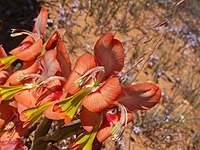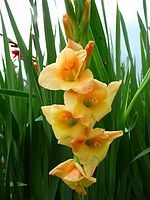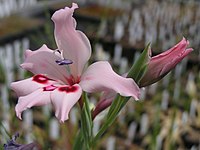Gladiolus
| Gladiolus | |
|---|---|
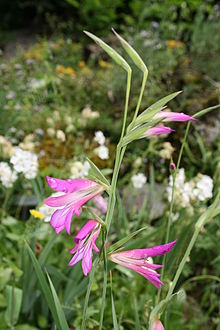
| |
| Gladiolus italicus | |
| Scientific classification | |
| Kingdom: | Plantae |
| Clade: | Tracheophytes |
| Clade: | Angiosperms |
| Clade: | Monocots |
| Order: | Asparagales |
| Family: | Iridaceae |
| Subfamily: | Crocoideae |
| Tribe: | |
| Genus: | Gladiolus L. |
| Type species | |
| Gladiolus communis L.
| |
| Species | |
|
About 260, see text | |
| Synonyms[1] | |
| |
Gladiolus (from Latin, the diminutive of gladius, a sword[2]) is a genus of perennial cormous flowering plants in the iris family (Iridaceae).[3]
It is sometimes called the 'sword lily', but is usually called by its generic name (plural gladioli).[4]
The genus occurs in Asia, Mediterranean Europe, South Africa, and tropical Africa. The center of diversity is in the Cape Floristic Region.[5] The genera Acidanthera, Anomalesia, Homoglossum, and Oenostachys, formerly considered distinct, are now included in Gladiolus.[6]
Description[]
Gladioli grow from round, symmetrical corms,[7] (similar to crocuses) that are enveloped in several layers of brownish, fibrous tunics.[8]
Their stems are generally unbranched, producing 1 to 9 narrow, sword-shaped, longitudinal grooved leaves, enclosed in a sheath.[2] The lowest leaf is shortened to a cataphyll. The leaf blades can be plane or cruciform in cross section.
The flowers of unmodified wild species vary from very small to perhaps 40 mm across, and inflorescences bearing anything from one to several flowers. The spectacular giant flower spikes in commerce are the products of centuries of hybridisation and selection.
The flower spikes are large and one-sided, with secund, bisexual flowers, each subtended by 2 leathery, green bracts. The sepals and the petals are almost identical in appearance, and are termed tepals. They are united at their base into a tube-shaped structure. The dorsal tepal is the largest, arching over the three stamens. The outer three tepals are narrower. The perianth is funnel-shaped, with the stamens attached to its base. The style has three filiform, spoon-shaped branches, each expanding towards the apex.[9]
The ovary is 3-locular with oblong or globose capsules,[9] containing many, winged brown, longitudinally dehiscent seeds.
These flowers are variously coloured, ranging from pink to reddish or light purple with white, contrasting markings, or white to cream or orange to red.[10]
Ecology[]
The South African species were originally pollinated by long-tongued anthophorini bees,[11] but some changes in the pollination system have occurred, allowing pollination by sunbirds, noctuid and Hawk-moths, long-tongued flies and several others.[12] In the temperate zones of Europe many of the hybrid large flowering sorts of gladiolus can be pollinated by small well-known wasps. Actually, they are not very good pollinators because of the large flowers of the plants and the small size of the wasps. Another insect in this zone which can try some of the nectar of the gladioli is the best-known European Hawk-moth Macroglossum stellatarum which usually pollinates many popular garden flowers like Petunia, Zinnia, Dianthus and others.[13]
Gladioli are used as food plants by the larvae of some Lepidoptera species including the Large Yellow Underwing,[14] and gladiolus thrips.[15]
Horticulture[]
Gladioli have been extensively hybridized and a wide range of ornamental flower colours are available from the many varieties.[10] The main hybrid groups have been obtained by crossing between four or five species, followed by selection: 'Grandiflorus', 'Primulines' and 'Nanus'. They can make very good cut flowers for display.[10]
The majority of the species in this genus are diploid with 30 chromosomes (2n=30) but the Grandiflora hybrids are tetraploid and possess 60 chromosomes (2n=4x=60). This is because the main parental species of these hybrids is Gladiolus dalenii which is also tetraploid and includes a wide range of varieties (like the Grandiflora hybrids).[10]
Species[]
The genus Gladiolus contains about 300 species, the World Checklist of Selected Plant Families had over 276 species in 1988,[10] As of February 2017, it accepted 300 species.[16]
There are 260 species of Gladiolus endemic to southern Africa,[7] and 76 in tropical Africa. About 10 species are native to Eurasia.[17]
The genus Gladiolus has been divided into many sections. Most species, however, are only tentatively placed.
- Andrews
- (Brongn. ex Lem.) B.D.Jacks.
- P.A.Duvign. & Van Bockstal
- [18]
- Herb.
- Gladiolus alatus L. (sect. Hebea)
- Goldblatt & J.C.Manning
- Goldblatt
- (Boiss.) Stapf
- Goldblatt
- Gladiolus angustus L. (sect. Blandus) – long-tubed painted lady
- A.P.Ham.
- Goldblatt
- Goldblatt &
- Klatt
- Goldblatt & J.C.Manning
- Baker
- Boiss.
- Kit Tan
- Klatt
- Baker – golden gladiolus
- Goldblatt
- Harms
- Baker (sect. Ophiolyza)
- L.Bolus
- (Baker) Goldblatt
- Goldblatt & M.P.de Vos
- Goldblatt
- Bolus f.
- Jacq. (sect. Linearifolius)
- G. Lewis
- (L. Bolus) Goldblatt
- Thunb. ex G. Lewis – Caledon bluebell.[19][20]
- Goldblatt &
- G. Lewis
- Goldblatt
- Goldblatt
- (Rendle) Goldblatt
- Curtis (sect. Blandus)
- Aiton – occurring in Darling, South Africa, and locally called the "blou pypie" ("blue pipe")[21]
- C. H. Wright (sect. Blandus) – cliff lily
- Gladiolus carneus F.Delaroche (sect. Blandus) – large painted lady
- Gladiolus caryophyllaceus (Burm. f.) Poiret
- Oberm.
- Herb.
- L. Bolus
- Goldblatt
- Marais
- Gladiolus communis L. (sect. Gladiolus) – common cornflag,[22][23] (type species)
- G.J.Lewis
- Gladiolus crassifolius Baker
- L. Bolus
- T. Moore (sect. Ophiolyza)
- (L.) Gaertn.
- Marais
- P.A.Duvign. & Van Bockstal ex S.Córdova
- G. Lewis
- Gladiolus dalenii (sect. Ophiolyza)
- F.Bolus
- De Wild.
- Ker Gawler (sect. Homoglossum) – small painted lady
- Goldblatt
- Baker
- Goldblatt
- Baker
- Goldblatt
- Gladiolus dichrous (Bullock) Goldblatt
- Goldblatt & J.C.Manning
- Goldblatt & J.C.Manning
- Oberm.
- Eristavi
- Lehm.
- Baker (sect. Ophiolyza)
- L. Bolus
- G. Lewis
- Gladiolus equitans Thunb. (sect. Hebea)
- Baker
- G. Lewis
- G.J.Lewis
- Goldblatt
- Goldblatt & J.C.Manning
- Goldblatt & J.C.Manning
- Gladiolus flanaganii Baker – suicide gladiolus
- Goldblatt
- Jacq.
- (L.Bolus) Goldblatt & M.P.de Vos
- L. Bolus
- Geerinck
- Jacq. (sect. Homoglossum) – reed bells
- Baker
- Andrews (sect. Blandus)
- Baker
- Welw. ex Baker (sect. Densiflorus)
- Goldblatt & J.C. Manning
- Kunze
- (Rendle) Marais
- F. Bol. (sect. Linearifolius)
- Gabrieljan
- Boiss. & Heldr.
- Vaupel
- Jacq. (sect. Linearifolius) – small pink Afrikaner, lapmuis
- L. Bolus
- Goldblatt
- (Welw. ex Baker) Goldblatt
- Stapf
- (N.E.Br.) Goldblatt & M.P.de Vos
- Jacq.
- Gladiolus illyricus W.D.J.Koch – wild gladiolus
- Gladiolus imbricatus L.
- Baker
- Thunb.
- Goldblatt & J.C. Manning
- Goldblatt & J.C. Manning
- Goldblatt
- G. J. Lewis
- D.Delaroche (sect. Hebea)
- (A. Chev.) Marais
- Gladiolus italicus P. Mill. (sect. Gladiolus) – Italian gladiolus, cornflag
- Eckl. ex G.J.Lewis
- Goldblatt
- G. Lewis
- Goldblatt & J.C.Manning
- Boiss.
- Goldblatt
- Baker
- P.A.Duvign. & Van Bockstal
- Marais
- Bolus f.
- Houtt. (sect. Homoglossum)
- Vaupel
- Goldblatt
- Baker (sect. Homoglossum)
- Cufod.
- Hilliard & Burtt
- Goldblatt
- Lam.
- Oberm.
- Sweet
- (Harms) Goldblatt
- Goldblatt & J.C. Manning
- Goldblatt
- Gladiolus mariae van der Burgt
- G. Lewis
- L. Bolus (sect. Homoglossum)
- (G. Lewis) Goldblatt & J.C. Manning
- Baker (sect. Ophiolyza)
- Gabrieljan
- (Schweinf.) Goldblatt
- G.J.Lewis
- Goldblatt
- Baker, 1901
- G. Lewis
- P.A.Duvign. & Van Bockstal ex S.Córdova
- Eckl.
- Vaupel
- G. Lewis ex Goldblatt & J.C. Manning
- Baker
- L. Bolus
- F. Vaup
- Mikheev
- Gladiolus murielae Kelway (syn. G. callianthus) – Abyssinian gladiolus
- G.J.Lewis
- Goldblatt
- G. Lewis
- Goldblatt
- Goldblatt
- Rolfe
- Baker (sect. Densiflorus)
- Baker
- Baker
- Herbert (sect. Ophiolyza)
- Gladiolus orchidiflorus Andrews (sect. Hebea)
- Schltr.
- Klatt
- Goldblatt & M.P.de Vos
- Gladiolus palustris Gaudin – marsh gladiolus
- Hook. f. (sect. Densiflorus) – goldblotch gladiolus
- Baker (sect. Blandus)
- Goldblatt & J.C. Manning
- Schltr.
- Gladiolus patersoniae Bolus f.
- Baker ex Oliv.
- Goldblatt & J.C. Manning
- Delaroche (sect. Hebea)
- Goldblatt
- Boiss.
- Goldblatt & J.C.Manning
- Gladiolus pole-evansii Verd.
- Marais
- Kuntze
- (N. E. Br.) Goldblatt & De Vos
- Diels
- Vaupel
- G. Lewis
- (G. Lewis) Goldblatt & J.C. Manning
- P.A.Duvign. & Van Bockstal ex S.Córdova
- Goldblatt
- (Burm. f.) Ker Gawler
- (Delaroche) Barnard
- L. (sect. Homoglossum)
- Goldblatt & J.C.Manning
- Baker
- J.C.Manning & Goldblatt
- Goldblatt
- Bolus f.
- P.A.Duvign.
- Baker
- Chiov.
- Goldblatt & J.C. Manning
- Goldblatt
- Lichtst. ex Roem. & Schult.
- G.J.Lewis
- F. Vaupel
- (Klatt) Goldblatt & M.P. de Vos
- P.A.Duvign. & Van Bockstal ex S.Córdova
- G. Lewis
- Hook. f. – Saunders' gladiolus, Lesotho lily
- Goldblatt & J.C.Manning
- Goldblatt & J.C.Manning
- Baker
- Baker
- P.J.D.Winter
- G.J.Lewis
- Goldblatt
- Goldblatt
- Hook. f.
- Goldblatt & J.C. Manning
- Goldblatt & Thulin
- Thunb.
- (Sweet) Herbert
- Oberm.
- G. Lewis
- Goldblatt
- Goldblatt
- G.J.Lewis
- G. Lewis
- Goldblatt
- (G. Lewis) Goldblatt & J.C. Manning
- Goldblatt
- F.Bolus
- Grossh.
- Schltr.
- M. Bieb.
- Goldblatt & De Vos
- Ker Gawl. (sect. Homoglossum)
- Gladiolus triphyllus (Sm.) Ker Gawl.
- Gladiolus tristis L. (sect. Homoglossum)
- P.A.Duvign. & Van Bockstal
- Goldblatt & Vlok
- Gladiolus undulatus L. (sect. Blandus) – large white Afrikaner, wall gladiolus
- Baker
- Marais ex Goldblatt
- L. Bolus ex G. Lewis
- Bolus f. (sect. Homoglossum)
- (L. Bolus) Goldblatt & De Vos
- (G.J.Lewis) Goldblatt & J.C.Manning
- Bolus f.
- De Wild.
- G. Lewis (sect. Hebea)
- De Wild. & T.Durand
- Oberm.
- Barnard
- Kies
- G.J.Lewis
- Thunb. (sect. Hebea)
- Goldblatt & J.C.Manning
- G. Lewis
- L.Bolus (sect. Hebea)
- Gladiolus watsonioides Baker – Mackinder's gladiolus
- Gladiolus watsonius Thunb. (sect. Homoglossum)
- (Baker) Goldblatt & J.C.Manning
- Baker
- Baker
- Goldblatt
Known hybrids include:
- Gladiolus × colvillii (G. cardinalis × G. tristis): Colville's gladiolus
- (G. dalenii × G. oppositiflorus) (sect. Ophiolyza)
Gladiolus alatus, Clanwilliam, RSA
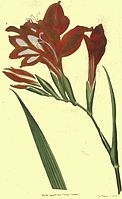
from Curtis's Botanical Magazine 1790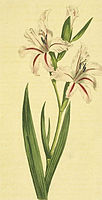
Waved-flowered Gladiolus (Gladiolus undulatus)
from Curtis's Botanical Magazine 1801
Gladiolus hybrid, Grandiflorus group
Gladiolus × hortulanus

Gladiolus × hortulanus 'Priscilla' photographed in visible, ultraviolet (showing Nectar guides), and infrared light
Cultivation[]
In temperate zones, the corms of most species and hybrids should be lifted in autumn and stored over winter in a frost-free place, then replanted in spring. Some species from Europe and high altitudes in Africa, as well as the small 'Nanus' hybrids, are much hardier (to at least −15 °F/-26 °C) and can be left in the ground in regions with sufficiently dry winters. 'Nanus' is hardy to Zones 5–8. The large-flowered types require moisture during the growing season, and must be individually staked as soon as the sword-shaped flower heads appear. The leaves must be allowed to die down naturally before lifting and storing the corms. Plants are propagated either from small cormlets produced as offsets by the parent corms, or from seed. In either case, they take several years to get to flowering size. Clumps should be dug up and divided every few years to keep them vigorous.[15]
They are affected by thrips, (thrip simplex),[15][24] and wasps , which burrow into the flowers causing them to collapse and die.[25]
Numerous garden cultivars have been developed, of which ‘Robinetta’ (a G. recurvus hybrid), with pink flowers, has gained the Royal Horticultural Society’s Award of Garden Merit.[26][27]
In culture[]
- Gladiolus is the birth flower of August.[28]
- Gladioli are the flowers associated with a fortieth wedding anniversary.
- American Ragtime composer Scott Joplin composed a rag called “Gladiolus Rag”[29]
- "Gladiolus" was the word Frank Neuhauser correctly spelled to win the 1st National Spelling Bee in 1925.[30]
- The Australian comedian and personality Dame Edna Everage's signature flowers are gladioli, which she refers to as "gladdies".[31]
- The Mancunian singer Morrissey is known to dance with gladioli hanging from his back pocket or in his hands, especially during the era of The Smiths.[32] This trait of his was made known in the music video for "This Charming Man", where he swung a bunch of yellow gladioli while singing.[33]
- Gladiolus in art

Vase with Red Gladioli (1886) by Vincent van Gogh
Gladiole by
References[]
- ^ "Gladiolus". Royal Botanic Gardens, Kew: World Checklist of Selected Plant Families. Retrieved 10 April 2014.
- ^ Jump up to: a b Perry, Dr. Leonard. "Gladiolus". pss.uvm.edu. Retrieved 2 February 2017.
- ^ Manning, John; Goldblatt, Peter (2008). The Iris Family: Natural History & Classification. Portland, Oregon: Timber Press. pp. 138–42. ISBN 978-0-88192-897-6.
- ^ Shorter Oxford English dictionary: 6th edition. United Kingdom: Oxford University Press. 2007. ISBN 978-0199206872.
- ^ Goldblatt, P. &, J.C. Manning. Gladiolus in Southern Africa : Systematics, Biology, and Evolution. Fernwood Press, Cape Town; 1998.
- ^ Goldblatt, P.; De Vos, M. P. (1989). "The reduction of Oenostachys, Homoglossum and Anomalesia, putative sunbird pollinated genera, in Gladiolus L. (Iridaceae-Ixioideae)". Bulletin du Muséum National d'Histoire Naturelle, Section B. 11 (4): 417–428.
- ^ Jump up to: a b Trevor R. Hodkinson and John A.N. Parnell (Editors) Reconstructing the Tree of Life: Taxonomy and Systematics of Species Rich Taxa, p. 158, at Google Books
- ^ "The Purple Gladiolus". wordpress.com. 11 September 2011. Retrieved 2 February 2017.
- ^ Jump up to: a b William Berman How to Dissect, p. 207, at Google Books
- ^ Jump up to: a b c d e A. Mujib (Editor) Somatic Embryogenesis in Ornamentals and Its Applications, p. 188, at Google Books
- ^ Goldblatt, Peter; Manning, John C.; Bernhardt, Peter (October 1997). "Notes on the Pollination of Gladiolus brevifolius (Iridaceae) by Bees (Anthophoridae) and Bee Mimicking Flies (Psilodera: Acroceridae)". Journal of the Kansas Entomological Society. 70 (4): 297–304. JSTOR 25085792.
- ^ Goldblatt, Peter; Manning, John C. (2006). "Radiation of Pollination Systems in the Iridaceae of sub-Saharan Africa". Ann. Bot. 97 (3): 317–344. doi:10.1093/aob/mcj040. PMC 2803647. PMID 16377653.
- ^ Alexandersson, R; Johnson, SD. (2002). "Pollinator-mediated selection on flower-tube length in a hawkmoth-pollinated Gladiolus (Iridaceae)". Proc R Soc Lond B. 269 (1491): 631–636. doi:10.1098/rspb.2001.1928. PMC 1690929. PMID 11916480.
- ^ David J. Carter Pest Lepidoptera of Europe: With Special Reference to the British Isles, p. 302, at Google Books
- ^ Jump up to: a b c Lloyd, Christopher (2000). Garden Flowers. Cassell and Co. pp. 170–172. ISBN 0304354279.
- ^ "Search for Gladiolus". World Checklist of Selected Plant Families. Royal Botanic Gardens, Kew. Retrieved 2 February 2017.
- ^ Rina Kamenetsky and Hiroshi Okubo (Editors) Ornamental Geophytes: From Basic Science to Sustainable Production, p. 24, at Google Books
- ^ "Gladiolus acuminatus F.Bolus – The Plant List". theplantlist.org. Retrieved 9 April 2018.
- ^ "Gladiolus bullatus". rhs.org. Retrieved 3 March 2018.
- ^ Foden, W.; Potter, L. (2005). "Caledon Bluebell". redlist.sanbi.org/. Retrieved 3 March 2018.
- ^ "More About Us". Archived from the original on 28 August 2017.
- ^ "Gladiolus Communis". the.botanical-magazine.com. Retrieved 3 March 2018.
- ^ "Gladiolus communis". rhs.org. Retrieved 3 March 2018.
- ^ Ramon Albajes, Maria Lodovica Gullino, Joop C. van Lenteren and Yigal Elad (Editors) Integrated Pest and Disease Management in Greenhouse Crops, p. 513, at Google Books
- ^ Arnold S. Menke Sphecid Wasps of the World: A Generic Revision, p. 420, at Google Books
- ^ "RHS Plantfinder – Gladiolus 'Robinetta'". Retrieved 16 February 2018.
- ^ "AGM Plants – Ornamental" (PDF). Royal Horticultural Society. July 2017. p. 43. Retrieved 2 March 2018.
- ^ "August Birth Flowers". almanac.com. Retrieved 2 February 2017.
- ^ "Gladiolus Rag". Library of Congress, Washington, D.C. 20540 USA. Retrieved 14 October 2020.
- ^ "Champions and their winning words". spellingbee.com/. Archived from the original on 17 November 2012. Retrieved 2 February 2017.
- ^ Dame Edna Everage and gladioli
- ^ "Entertainment – Rainy-day voice of a generation". BBC.
- ^ YouTube – via YouTube.
Bibliography[]
- G. R. Delpierre and N. M. du Plessis (1974). The winter-growing Gladioli of Southern Africa. Tafelberg-Uitgewers Beperk 120 colour photographs and descriptions.
- Peter Goldblatt (1996). A monograph of the genus Gladiolus in tropical Africa (83 species). Timber Press
- Peter Goldblatt, J. C. Manning (1998). Gladiolus in southern Africa: Systematics, Biology, and Evolution, including 144 watercolor paintings. Cape Town: Fernwood Press.
External links[]
| Wikimedia Commons has media related to Gladiolus. |
| Wikisource has the text of the 1911 Encyclopædia Britannica article Gladiolus. |
- Dressler, S.; Schmidt, M. & Zizka, G. (2014). "Gladiolus". African plants – a Photo Guide. Frankfurt/Main: Forschungsinstitut Senckenberg.
- Gladiolus
- Cormous plants
- Garden plants
- Iridaceae genera
